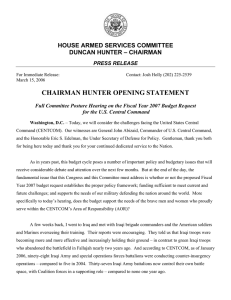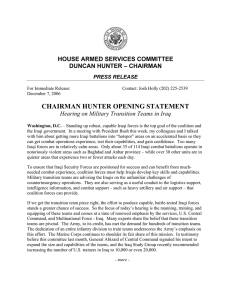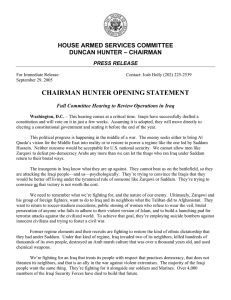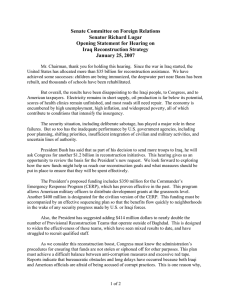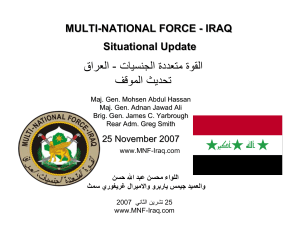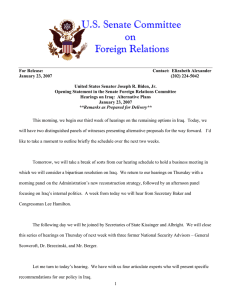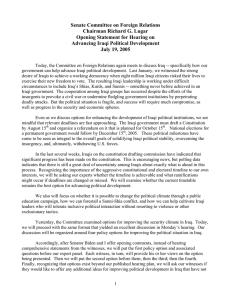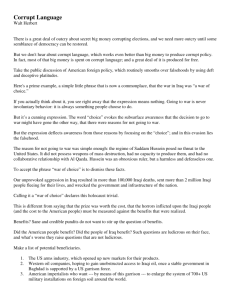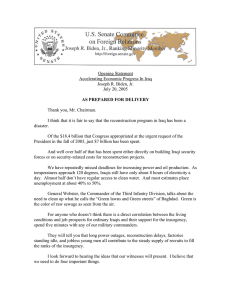U.S. OCCUPATION IN IRAQ AND JAPAN: A BRIEF COMPARISON
advertisement
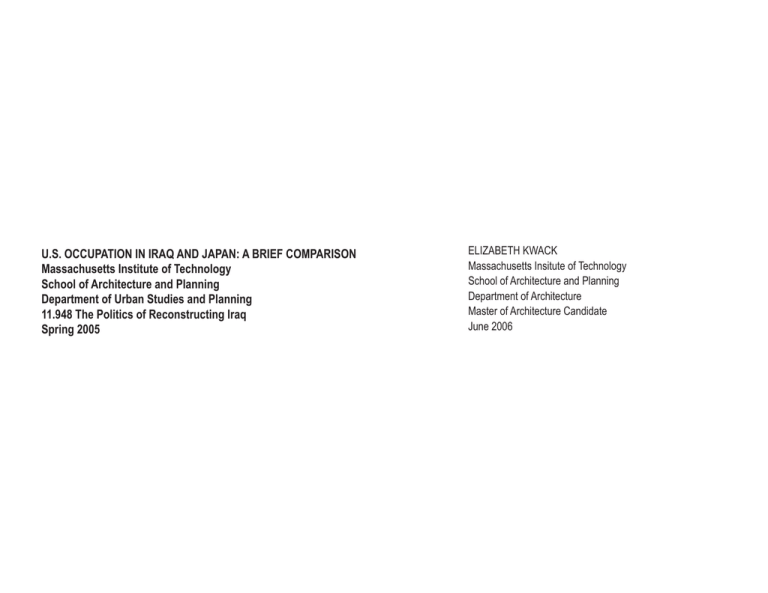
U.S. OCCUPATION IN IRAQ AND JAPAN: A BRIEF COMPARISON Massachusetts Institute of Technology School of Architecture and Planning Department of Urban Studies and Planning 11.948 The Politics of Reconstructing Iraq Spring 2005 ELIZABETH KWACK Massachusetts Insitute of Technology School of Architecture and Planning Department of Architecture Master of Architecture Candidate June 2006 GOAL OF OCCUPATION IN JAPAN To ensure that “the present economic and social system in Japan which makes for a will to war will be changed so that the will to war will not continue.” Assistrant Secretary of State Dean Acheson GOAL OF OCCUPATION IN IRAQ “Among the key policy objectives laid out by the Bush Administration in conjunction with the war in Iraq was the economic and political reconstruction of the country. Discussion and debate within the United States government and abroad have been ongoing regarding the strategy to reach these ends utilizing reconstruction aid funds and the effectiveness of aid implementation.” US Embassy June 1, 2004 Iraqi Goverining Body is dissolved and new governent leaders are named. June 28, 2004 Power to govern is handed to Iraq’s interim government and the Coalition Provisional Aurthority is dissolved. Janurary 30, 2005 Elections for a transitional National Assembly take place. The National Assembly will draft a permanent constitution. August 15, 2005 Deadline for National Assembly to draft a permanent constitution. October 15, 2005 Deadline for draft or permanent constitution to go to Iraqi people for approval in a general referendum. December 15, 2005 If constitution is approved, elections for a permanent goverment to be held by this date. December 31, 2005 New government to assume office by this date. National Assembly 275 members, the National Assembly will serve as Iraq’s legislature. Electoral law requires at least 25 percent of the body to be women. Once in place, the National Assembly will elect its own leaders and the state’s Presidency Council. Presidency Council The Presidency council consists of the President and two vice presidents. The president is the commander in chief of the Iraqi military and appoints the country’s Prime Minister. Prime Minister The Prime Minister controls the day-to-day activities of the government and makes recommendations to the Presidency council on members of the Council of Ministers. Council of Ministers The Council of Ministers represents the various departments within the government (e.g., Health, Justice, Transportation, Foreign Affairs). Each ministry may nominate deputy ministers, ambassadors and other staff. High Judicial Council The Higher Judicial Council will oversee the federal judiciary and its budget. The council will consist of the Federal Supreme Court’s presiding judge and the presiding and deputy judges of several lower courts. Federal Supreme Court The Presidency council will appoint the nine members (including one presiding judge) of the Federal Supreme Court, who will make judicial decisions by simple majority. Lower courts include the country’s Central Criminal Court, Courts of Appeal and the Court of Cassation. GOAL OF OCCUPATION IN JAPAN To ensure that “the present economic and social system in Japan which makes for a will to war will be changed so that the will to war will not continue.” Assistrant Secretary of State Dean Acheson GOAL OF OCCUPATION IN IRAQ “Among the key policy objectives laid out by the Bush Administration in conjunction with the war in Iraq was the economic and political reconstruction of the country. Discussion and debate within the United States government and abroad have been ongoing regarding the strategy to reach these ends utilizing reconstruction aid funds and the effectiveness of aid implementation.” US Embassy HOW JAPAN DIFFERS FROM IRAQ: LEGITIMACY - Legitimate war - Legitimate, unconditional surrender from an intact government that remained intact after the surrender - Legitmate economics (no real appearance of war profiteering) SOCIAL COHESION - No ethnic, regional, religous factions as found in Iraq CLEAR OBJECTIVES FROM OUTSET - Potsdam Declaration clearly announced terms of surrender by US, UK, and China - “United States Initial Post-Surrender Policy Relatiing to Japan” - Comprehensive military directive elaborating on the postsurrender policy (First two documents were almost immeidately made public documents, while the third remained secret until November 1948) NO OPPOSITION/HOSTILE REACTIONS TO OCCUPATION FROM WITHIN - “Revolution from Above” - Americans depicted as godlike, omnipotent, “gifts from heaven”, MacArthur’s orders received from the “hand of God” - “We express our deepest gratitude that the occupation of Japan by teh Allied Forces, dedicated to liberating the world from fascism and militarism, has opened the way for teh democratic revolution in Japan.” Tokuda Kyuichi, Communist Party leader - Kato Esturo, Okurareta Kakumei (“The Revolution We Have Been Given”) WHAT HAPPENED IN JAPAN: REBUILDING FROM WITHIN - No Marshall Plan for Japan. Burden of reconstruciton fell mostly on the Japanese themselves. - Occupation resulted in abolished military, forbiddence of war-related military production, huge population of planners, capitalists, managers, engineers, skilled work manufacturers began heavy construction equipment production, large electronic companies like Hatichi adndToshiba that subcontracted for the military moved to the manufacturing of consumer goods. This shift gave rise to companies like Honda and Sony. - Eco ‘PRO-STATE, ANTI-FOREIGNER” - 1949, Mnistry of Interntational Trade and Industry (MITI) created for the expicit purpose of expediting Japan’s export-oriented pro- ductivity. (later in the 70s Americans denouced it as a perfect example of Japan’s unfair trade practices.) - Japanese government introduced legislatoin restricting foreign influnece over the domestic economy. Wanted to achiece “self-suf- ficiency”, “state-in, foreigners-out” policy of the 1970s and 80s. WHAT’S HAPPENING IN IRAQ: RECONSTRUCTION PRIORITIES OCTOBER 2003 (CPA’s original priorities as apprived by Congress) 22% , customs personnel) 67% aimed at improving infrastructure to stabilize country through job opportunities and stimulating the economy (electricity, oil production, water and sewerage, transportation, telecommunications) ~10% for technical assistance, small scale grants in areas such as democratization, civil society, microenterprise, education, economic policy, health, etc. NOVEMBER 2003 Agreement to accelerate the hand-over of sovereignty to Iraqis led the Administration to revise plans in January 2004: Broad categories remained nearly the smae, excpet for the oil sector, where emergency supply efforts were cut by nearly $200 million. However, a number of funding changes were made within sectors. The most significant change was an increase in the democratization effort — from $100 million to $458 million — reflecting the more intensive plan to prepare Iraqis to takeover. Increases were made as well in funding for border enforcement (from $150 to $300 million) and the civil defense corps (from $76 to $200 million). SEPTEMBER 2004 32% security 51% infrastructure 16% democratization RECONSTRUCTION PROGRAMS Restocking of ministries following massive looting after initial invasion Rehabilitation of health facilities (training of health care providers, immunization for children) Establishment of neighborhood councils in 445 locations ~2,000 grassroots projects conducted through USAID grants ($92 mil) to provide community action groups Provision of school matierials, inventory adn renovation of schools STATUS OF RECONSTRUCTION: Only a few hundred of the 2,300 construction projects identified bythe Project and Contracting Office appear to have been completed. Objectives in critical sectors, such as oil production and electric power generation, have not been met. Electri Oil production reached a post-war peak in late September at 2.67 million barrels/day, and the goal is 2.8-3.0 million by December. Most of the Iraqi police have not yet been trained. The one consistent bright spot among reconstruction claims — a successful health program — was marred by reports that acute malnutrition among children has nearly doubled since the coalition invasion in 2003. Iraqis voted January 30 to elect members of the new National Assembly from a list of 111 coalitions, parties and individuals, representing nearly 8,000 candidates. GRAND AYATOLLAH ALI AL-SISTANI Backer, United Iraqi Alliance Although not on the ballot as a candidate, the influential Shiite cleric backs the United Iraqi Alliance, a Shiite-dominated coalition of political parties and individuals. He has called voting in the election “a religious duty.” IBRAHIM AL-JAAFARI Candidate, United Iraqi Alliance Party: Dawa Party Al-Jaafari, a Shiite Muslim, is one of two vice presidents in the Iraqi interim government. He is a member of the Dawa movement, which seeks to modernize Iraq’s religious institutions. HUSSAIN AL-SHAHRISTANI Candidate, United Iraqi Alliance Al-Shahristani is a nuclear scientist who was one of six people chosen by the Grand Ayatollah al-Sistani to compile a list of candidates for the United Iraqi Alliance. ADEL ABDUL MAHDI Candidate, United Iraqi Alliance Party: Supreme Council for the Islamic Revolution in Iraq ABDEL-AZIZ AL-HAKIM A Shiite and the finance minister in the Iraqi interim government, Mahdi is a trained economist who, after being stripped of his job, left Iraq in 1969 for exile in France, where he worked for several French think tanks, and edited magazines in French and Arabic. Party: Supreme Council for the Islamic Revolution in Iraq AHMED CHALABI Candidate, United Iraqi Alliance Party: Iraqi National Congress ADNAN PACHACHI Chalabi is a secular Shiite and founder of the Iraqi National Congress, which comprises exiles, Kurds and Shiites. He was a key U.S. ally before the invasion of Iraq in 2003 but fell out of favor when his intelligence about weapons of mass destruction failed to pan out. Pachachi is a secular Sunni Muslim who had belonged to the disbanded Iraqi Governing Council. He was a foreign minister of the government deposed by Saddam Hussein’s Baath Party in 1968. Candidate, United Iraqi Alliance Al-Hakim, a Shiite, was a member of the disbanded Iraqi Governing Council. He is the leader of the Supreme Council for the Islamic Revolution in Iraq. Candidate, Independent Democratic Gathering JALAL TALABANI Candidate, Kurdish List Party: Patriotic Union of Kurdistan Talibani is a Sunni Kurd and the founder and leader of the Patriotic Union of Kurdistan, one of two main northern Kurdish parties that have joined to present a list of candidates for the election. MASSOUD BARZANI Candidate, Kurdish List Party: Kurdistan Democratic Party Barzani, an ethnic Kurd and Sunni Muslim, was a member of the former Iraqi Governing Council. He is a leader of the Kurdistan Democratic Party, one of two key northern Kurdish parties that have joined to present a list of candidates for the election. AYAD ALLAWI Candidate, The Iraqi List Party: Iraqi National Accord Allawi, a Shiite Muslim, is the prime minister of the interim Iraqi government. He is a former Baath Party member who was on the disbanded Iraqi Governing Council. HAMID MAJID MOUSSA Candidate, Iraqi Communist Party Moussa, a Shiite Muslim, was on the former Iraqi Governing Council and leads the Iraqi Communist Party. He draws support from urban Shiites and Kurds. NASEER AL-CHADERCHI Candidate, National Democratic Party Al-Chaderchi, a Sunni Muslim, was a member of the Iraqi Governing Council and is the leader of the National Democratic Party. SHEIK GHAZI AL-YAWAR Candidate, The Iraqis Party Al-Yawar, a Sunni Muslim, is the president of the interim Iraqi government and was on the Iraqi Governing Council. He is the leader of a prominent Sunni tribe in northern Iraq.
